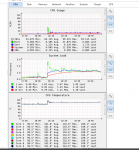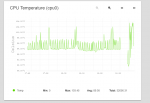@Apollo Have you had wrong temp readings with your 1900x ?
Yes, it has always been very spiky type readings.
I made some screenshots in the following post:
https://www.ixsystems.com/community/threads/amd-threadripper-build.70194/
Before doing the dive with the 1900x, I had was able to test the 1950x for short while to evaluate performance under Windows, I was impressed. Then I decided placing an order for my own PC at Amazon when they screwed my order and decided they would cancel it rather than honoring it (I am still ranting about it) and no longer buy from them. When second Gen 2950x came out I purchased one to make it my personal PC from another distributor of course.
When I first put it together, I got high temperature especially at bootup where temperature (displayed on motherboard) would be going near or on the high side of 90 degrees C.
I wasn't sure this was correct and contacted AMD to find out, but they didn't seem very clear about it.
There are several ways temperature can be read from the processor, the package temperature or the various core temperatures.
I then conducted a series of test in order to evaluate effect of temperature and understand its behavior.
Threadripper has a very aggressive profile for power optimization and constantly adjust clock frequency and voltages based on CPU utilization requirements. As a result, you will see spikes of 10-15 degrees C when this happens, and it happens at regular rate.
If you disable dynamic precision boost and set frequency to be fix, like 2.4GHz, then you can achieve low temperatures close to room temperature but then again you waste on its performances.
I then tested the 2950x with running Freenas and I got similar temperature profiles it would seem.
When I got it working fine and performed a series of test, then I decided to buy the 1900x that is currently in my Freenas box right now. I wasn't entirely sure to expect the same support as it is first Gen but so far, except for a few early beta test issues, not specifically related to the 1900x, it has been very good.
Temperatures can be high as seen on the above post.
On my daily work on my PC running 2950x, I do often make use of all the cores and I have also ran benchmarkings tools to stress test the system and temperature can be very high in the upper 90 degrees C. When CPU gets really hot, you can see throddeling of frequency taking place. Because of it, I am not really worried. Overall, it does put less heat than my old i7-920 overclocked, but temperature transients are very significant.
I am also running ECC for the simple reason of data integrity.
Currently, Freenas doesn't report temperature per cores even though it appears to be the case.



